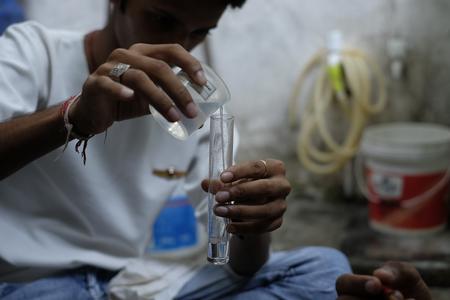Catching them young: Youth and water quality testing

Twenty year old Bharat holds the portable water quality testing kit and carefully climbs the stairs to Chandrawati’s house in east Delhi’s Sunder Nagri area. She looks on as Bharat opens a tap, collects water and begins testing it. First he checks pH levels—water free from impurities is neutral and the pH strip does not change colour. Then he moves on to testing temperature, coliform count, and turbidity.
‘’When fetching and drinking water, people usually check if the water is clear. If yes, they assume that it is safe to consume. But this is often not the case. Water looking clean might not be always safe,’’ Bharat says. This is often the case with most of us. While collecting or drinking water we just assume that if it is looking clean, it is safe to consume.
Youth groups in action
Bharat is part of a ‘Youth User Group’ first set up in 2012 by Action India in Sunder Nagri with support from WaterAid India, its local partner in Delhi. The idea is to bring together young men and women between the ages of 12–20 to educate them on the need for access to safe and clean water. A group usually has 10–15 members, and are taught 11 tests which can be performed easily in communities and do not involve rigorous technical procedures. They are then encouraged to visit individual homes, and common water points to check quality. Youngsters are great agents of change, and help sensitise an entire generation by motivating and sharing their learnings with their families and communities to demand clean and safe drinking water.
The complete range of tests takes three hours. While most show results immediately, some take longer to register and the community is informed consequently. “We do get the result of some tests in five minutes. But we inform the community of the complete results of all tests in 48 hours after correlating all findings,’’ Bharat informs.
The youth user groups guide the community on steps needed to get clean water in case the quality is not up to mark. They demonstrate simple tests which people can carry out at homes to test quality of water and store it safely. Action India also shares the details of the water testing by the youth groups through Jan Sunwais (public hearings) with Delhi Jal Board (DJB) officials for further action.
Timely Interventions
Bharat has been part of the user group at Sunder Nagri since its inception and says he cannot really remember the number of homes, and the number of times he has checked water quality or its impact in his community but he says the number must be over 100 easily. He does recollect one case distinctly. ‘’We once checked the water in a house in the community. The water was very dirty and totally unfit for drinking. We told him that he needs to go to DJB and submit an application. He did so and the authorities came in and checked the pipeline. They found that there was leakage and the surrounding dirt was being sucked in. They fixed the line and solved the issue.’’
Most households require simpler solutions, however. ‘’In some homes what is needed is just using chlorine tablets and boiling the water before drinking,’’ he says.
During the water testing the youth group also came across high ammonia and coliform levels in some water samples. They advise the community to approach the DJB and check for leakage and contamination. ”The water quality issues have come down over the years and even if they arise the community takes prompt action,” Bharat adds.
Diseases on the decline
Bharat mentions how jaundice, diarrhoea, fever and other infections were initially common in the community. ‘’Over the years I have seen cases go down. The community has understood the need for safe and clean water. In the beginning they would not allow us to enter their homes, or would ask us numerous questions before being allowed to collect water. Now the community seeks us out for testing.’’
The constant efforts by the youth groups over the years in testing water quality and sharing them with communities have ensured a change in attitude and behaviour of people towards water quality and testing.






